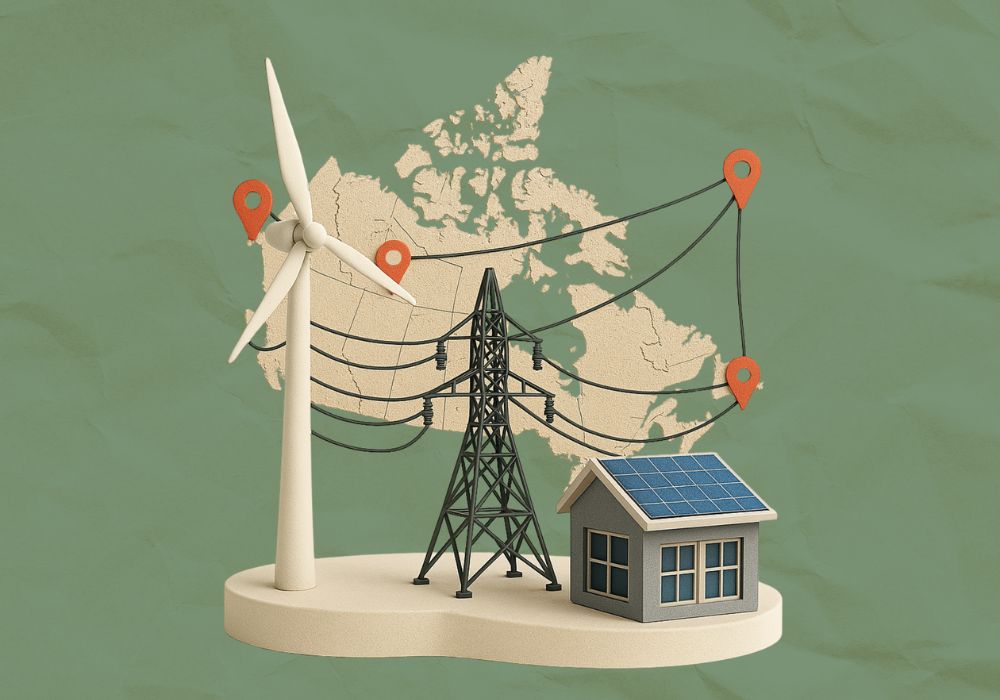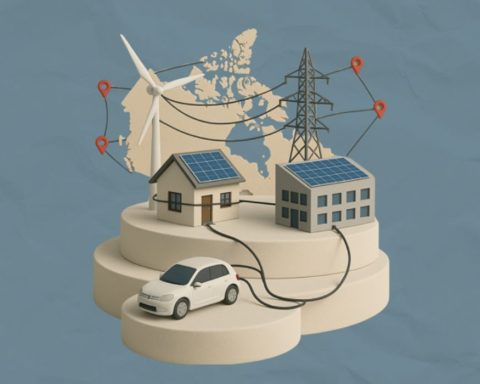Canada can save billions in unnecessary and unsustainable capital expenditures by pivoting now to renewables-based, emission-free electricity generation; a coast-to-coast transmission link; and smart grid technologies.
The vision of a decarbonized, interconnected, resilient national power grid is at the heart of recent analysis by Corporate Knights’ Climate Dollars project that sets out an ambitious plan for a zero-emission economy by 2050, all while securing and revitalizing the local economies that are the cornerstone of our national sovereignty.
It is a grid that we have only recently imagined, one based on millions of distributed, renewable generators rather than dozens of central power plants. It requires capital investments in solar, wind and storage technologies that total $700 billion over the next 25 years, in addition to the roughly equal amount of capital needed to electrify the buildings and vehicles. The capital cost for the grid investments averages $28 billion per year from now until 2050 and is below current investment level in the electric power sector in Canada, which totalled $32 billion in 2024 and is projected to reach $34.5 billion this year.
But while this total investment is well within the capacity of Canadian capital spending, realizing such a sustainable outcome requires that government make the right choices now, that both new and existing buildings are fossil fuel–free, that we develop vehicle-to-grid infrastructure that feeds the energy of EV batteries back into our grid, and that we stop building new fossil and nuclear plants.
The renewable grid builds on our current hydroelectric base and leans into the wind and solar resources that Canada has in abundance, and that are leading global growth in electricity generation investment.
- Sized to provide for the growth in electrification of buildings and vehicles, the scenario includes up to 100,000 wind turbines and 100 million solar panels to be built across Canada over the next 25 years.
- The batteries in tens of millions of interconnected electric vehicles will provide the energy storage to ensure a reliable grid, 24 hours a day, 365 days per year. By 2050, vehicle-to-grid technology cuts the cost of the national grid by half – even after putting money in vehicle owners’ pockets by compensating them for access to their batteries.
Every part of the Climate Dollars scenario is built on technologies that are proven, affordable and beginning to scale up. Getting it done will depend on government leadership in clearing regulatory and other barriers to rapid action, and an accelerated response from businesses and investors who see opportunities to prosper generated by a positive, pragmatic response to the climate emergency.
The Trans-Canada Transmission Link
At the heart of the transition scenario is what we are calling the Trans-Canada Transmission Link, a bold nation-building project as central to our future as the Trans-Canada Railway and Highway were to our past. It’s a coast-to-coast, high-voltage DC transmission line that will foster interprovincial trade in electricity to bring down the cost of decarbonization while supporting broad distribution of the benefits of the hundreds of billions of dollars of investment in renewable electricity through the coming transition.
A Trans-Canada Transmission Link will also be a more efficient means of transporting energy across the country than a new pipeline. As the energy transition unfolds, the link could transport gas-powered electricity generated in Alberta to Eastern Canada faster than pushing the gas across the country in a pipeline, with an important added benefit: the Trans-Canada Transmission Link will not be obsolete after the transition to zero-carbon sources is complete. The link will give each province access to electricity-generating capacity in any of the others, with different parts of the country using and consuming power at different times of day. With the grid itself as a coordinating point, Manitoba sunshine will be able to power the dinner-hour peak in Halifax, while Quebec’s summer winds supply morning electricity for office towers in Calgary and Edmonton.
The Trans-Canada Transmission Link is a bold nation-building project as central to our future as the Trans-Canada Railway and Highway were to our past.
A Canada-wide link also cuts the total amount of renewable generation the country will need. Rather than every province building its own carbon-free grid independently, a national link is stronger, and smarter, together. It will cost $30 to $40 billion to build, including the converter stations in each province, and deliver two to three times that much in cost savings.
The interprovincial transactions along the Trans-Canada Transmission Link will be a win for all provinces, whether they’re buying or selling electricity. The prospect of stable, new domestic markets will increase the incentive for hydropower-rich Newfoundland and Labrador, Quebec, Manitoba and British Columbia to develop their wind resources. And the easy availability of electrons through an east–west grid will help out provinces like Alberta, Saskatchewan and Ontario that will be hard pressed to independently develop all the renewable generation they need to decarbonize their economies by 2050.
The battery under your hood
Short-term energy storage, operating every hour of every day of the year, is the key to the renewable grid, delivering the flexibility to match the peaks and valleys of intermittent electricity supply with constantly fluctuating demand. In the Climate Dollars scenario, the battery under the hood of your electric vehicle is the most affordable way to deliver that reliability.
In the short to medium term, large, utility-scale batteries that can store 240,000 kilowatt-hours or more will support the transition to renewable electricity, and there will likely be a longer-term role for some of these large, more expensive batteries. In the longer run, however, the key to bringing down the cost of emissions-free electricity is to bring down the cost of storage.
In the Climate Dollars scenario, we tap into the millions of much smaller EV batteries that will be available from the electrification of road transport. The cars are generally parked 95% of the time and on any given day use only 10 to 20% of their battery capacity. With relatively inexpensive vehicle-to-grid (V2G) infrastructure that enables the cars to charge at times of day when solar electricity is abundant and partially discharge in the evening and overnight, the otherwise idle batteries become a key enabling technology for the transition to renewable electricity.
Utility and fleet managers in Canada and around the world are beginning to adopt V2G technology for load management and cost savings. In the Climate Dollars scenario, vehicle owners decide , but V2G becomes the universal way in which personal electric vehicles connect to the grid. With utility batteries costing more than $1,000 per kilowatt, access to EV batteries could be worth $10,000 to $20,000 per vehicle battery. In the Climate Dollars scenario, V2G cuts the cost of grid decarbonization in half, saving hundreds of billions of dollars – not because the car batteries are that much cheaper, but because they’re already embedded in the cost of the cars. Those vehicles, in turn, become more affordable to buy if their owners can count on revenue from a V2G contract.
Heat pumps and winter peak electricity consumption
In the Climate Dollars scenario, air-source and ground-source heat pumps are the key to eliminating fossil fuel consumption in residential and commercial buildings.
In most provinces, fossil fuels – mainly natural gas – provide most building space and water heating, and the conversion of millions of gas-heated buildings to heat pumps will result in strong growth in winter peak consumption of electricity. Fortunately, because the heat pumps are so efficient – providing anywhere from two to four units of heat for every kilowatt-hour of electricity they consume – it will require that much less energy to heat the buildings with heat pumps than it currently takes to heat them with gas.
RELATED:
Three big shifts that can transform and modernize Canada’s economy
Closing the climate funding gap is key to Canada’s prosperity
Electrifying driving in Canada will cost just 10% more than what we already spend
Nevertheless, there are millions of buildings to be converted, and the resulting growth in winter peak consumption of electricity is the defining factor in the capital investment required to establish and maintain a renewable, emission-free electricity supply.
Ensuring that all new buildings are built to high efficiency standards and retrofitting existing buildings for higher levels of efficiency can make a big difference in their peak consumption – more than $100 billion in capital savings if the retrofits are deep enough. There is also a large amount of industrial electricity consumption that occurs during the winter peak, and which could be responsive to seasonal load management and “time of year” pricing – for example, a manufacturing plant could scale back production from Christmas to the middle of February, and make it up in the spring. Here, again, the capital savings to the electricity system could add up to tens of billions of dollars.
Inevitably, though, any future grid that supplies an electrified building sector in a temperate climate will have a winter peak – in the Climate Dollars scenario, electricity consumption is higher in winter in every province. This will result in idle solar and wind capacity in the spring and the fall, idle capacity that will be available at very low cost to innovators who can devise applications for it.
Canada’s energy-supply mix in 2050
In the Climate Dollars scenario, oil and gas demand falls to nearly zero by 2050. The fuels we use for heating and cooling, vehicles, industry and agriculture are replaced by electricity, and that electricity is generated predominantly from wind, hydropower and solar.
- Wind turbines total 178 gigawatts of installed capacity with a national grid in place to balance demand, 235 GW without.
- With no new large hydropower dams in the scenario beyond projects that are already committed, installed hydro capacity remains steady at about 80 GW.
- Solar panels come in at just over 50 GW, 36.4 from utility-scale solar farms and 14 from rooftops in every part of the country.
- Total electricity end use increases from less than 600 to more than 1,000 terawatt-hours per year, including about 550 TWh in homes and commercial buildings, 150 TWh from road transport and nearly 330 TWh from industry and agriculture.
To chart a course to this renewable, decarbonized future, Climate Dollars modelled each of the separate, provincial grids that Canadians have relied on for nearly a century. The scenario includes detailed electricity supply and demand projections for most individual provinces, with an integrated analysis of the electricity supply for New Brunswick, Nova Scotia and Prince Edward Island. Highlights include:
- modest overall growth in energy and peak electricity demand in British Columbia and Quebec, with hydropower readily available and today’s heavy use of electric resistance heating creating opportunities to boost efficiency through heat pump conversions;
- increased reliance on wind resources in Alberta and Saskatchewan that are close to population centres and play a central role in decarbonizing the grid;
- more than a doubling of electricity consumption in Alberta and Ontario, with rising peak consumption in Ontario underscoring the opportunity to boost efficiency with cold-climate heat pumps and building retrofits;
- greater reliance on ground-source heat pumps in the three Prairie provinces;
- low overall energy consumption in Newfoundland and Labrador as the fossil fuel industry winds down, creating an opportunity for the province’s abundant hydropower resources to attract energy-intensive industries; and
- modest electricity demand growth in the Maritime provinces, where electric heating is already quite prevalent and the rise in peak demand is not as sharp as elsewhere.
Building new nuclear capacity increases the overall cost of decarbonization. A high-nuclear future in Ontario that includes proposed new plants at Bruce and Wesleyville costs $55 billion more than Climate Dollars’ lower-cost reference scenario, which includes only the spending already committed to rebuild old reactors.
Corporate Knights will release the full Climate Dollars analysis April 24, during Earth Week.
Corporate Knights is able to carry out this research thanks to support from the McConnell Foundation, the Trottier Family Foundation, the Chisholm Thomson Family Foundation and the Graham Boeckh Foundation.
The Weekly Roundup
Get all our stories in one place, every Wednesday at noon EST.







